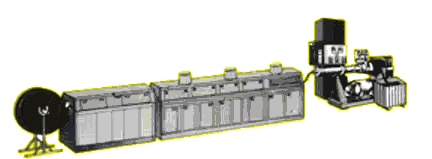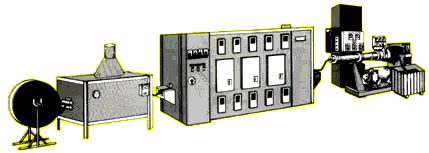|
DIE CUTTING
 
Any of our rubber sheet
or sponge products can be die cut by a variety of methods to obtain
your desired combination of quantity, tolerances, and price. We will
choose the method that best meets your needs.
We die cut rubber by the following
methods:
HAND CUT
(For large sizes and small quantities)
STEEL RULE DIE
(for mid-range quantities with commercial tolerances)
MALE-FEMALE FORGED
DIE (For larger quantities, tight tolerances, and lower
price)
WATER-JET (For
difficult shapes, thick parts)
LATHE CUT
EXTRUSIONS
Below are illustrations of the three methods of rubber extrusion.
They each have their own advantages. Unirubber will choose the
method that most efficiently and economically produces your
requirements. There are a infinite number of profiles that can be
extruded. The four most common are: TUBING, CHANNEL
RUBBER, CORD, AND BULB SEALS . Unirubber has thousands
of extrusion dies available. There is never a die charge for any
tubing or rubber cord profile. For most other rubber profiles the
die set-up charge in nominal

RUBBER EXTRUDATE
RUBBER EXTRUSION DIE
EXTRUSION METHODS
 
COLD OR HOT FEED
EXTRUDER
AUTOCLAVE FOR OPEN STEAM

WASH SYSTEM
SALT BATH VULCANIZATION
COLD FEED VACUUM

POST VULCANIZATION
OVEN MICROWAVE UNIT
COLD FEED VACUUM
MOLDED
PARTS
There are three
basic methods that can be employed to mold rubber products;
compression, transfer and injection. Choosing the right method
depends on several factors. they are:material, quantity, tolerances
and price. UniRubber will select the correct method to meet your
individual needs.
STANDARDS FOR DIMENSIONAL
TOLERANCES
Introduction
The purpose of this section is to list some of
the factors affecting tolerances. In general, the degree of
reproducibility of dimensions depends upon the type of tooling and
rubber used, and the state of the art. of the art.
Discussion of Factors Affecting Tolerances
There are many factors involved in the
manufacturing of molded rubber products which affect tolerances.
Since these may be peculiar to the rubber industry, they are listed
here.
Shrinkage
Shrinkage is defined as the difference between
corresponding linear dimensions of the mold and of the molded part,
both measurements being made at room temperature. All rubber
materials exhibit some amount of shrinkage after molding when the
part cools. However, shrinkage of the compound is also a variable in
itself and is affected by such things as material specification,
cure time, temperature, pressure, inserts, and post cure. The mold
designer and the compounder must determine the amount of shrinkage
for the selected compound and incorporate this allowance into the
mold cavity size. Even though the mold is built to anticipate
shrinkage, there remains an inherent variability which must be
covered by adequate dimensional tolerance. Shrinkage of rubber is a
volume effect. Complex shapes in the molded product or the presence
of inserts may restrict the lineal shrinkage in one direction and
increase it in another. The skill of the rubber manufacturer is
always aimed at minimizing these variables, but they cannot be
eliminated entirely.
Mold Design
Molds can be designed and built to varying
degrees of precision, but not at the same cost. With any type of
mold, the mold builder must have some tolerance, and therefore, each
cavity will have some variance from the others. Dimensional
tolerances on the product must include allowances for this fact. The
accuracy of the mold register must also be considered. This is the
matching of the various plates of the mold that form the mold
cavity. Register is usually controlled by dowel pins and bushings or
by self-registering cavities. For molds requiring high precision in
dimensions and register, the design work and machining must be more
precise and the cost of the molds will be greater than one with
commercial requirements.
Trim and Finish
The objectives of trimming and finishing
operations are to remove rubber material-such as flash, which is not
a part of the finished product. Often this is possible without
affecting important dimensions, but in other instances, some
material is removed from the part itself. Where thin lips or
projections occur at a mold parting line, mechanical trimming may
actually control the finished dimension.
Inserts
Most insert materials (metal, plastic, fabric,
etc.) have their own standard tolerances. When designing inserts for
molding to rubber, other factors must be considered, such as fit in
the mold cavities, location of the inserts with respect to other
dimensions t proper hole spacing to match with mold pins, and the
fact tha inserts at room temperature must fit into a heated mold. In
these matters, the rubber manufacturer can be of service in advising
on design features.
Distortion
Because rubber is a flexible material, its shape
can be affected by temperature. Distortion can occur when the part
is removed from the mold or when it is packed for shipment. This
distortion makes it difficult to measure the parts properly. Some of
the distortion can be minimized by storing the part as unstressed as
possible for 24 hours at room temperature. Some rubber will
crystalize (stiffen) when stored at low temperature and must be
heated to above room temperature to overcome this condition.
Envionmental Storage Conditions
Temperature: Rubber, like other materials,
changes in dimension with changes in temperature. Compared to other
materials the coefficient of expansion of rubber is high. To have
agreement in the measurement of products that are critical or
precise in dimension, it is necessary to specify a temperature at
which the parts are to be measured and the time required to
stabilize the part at that temperature.
Humidity: Some rubber materials absorb moisture.
Hence the dimensions are affected by the amount of moisture in the
product. For those products which have this property, additional
tolerance must be provided in the dimensions. The effect may be
minimized by stabilizing the product in an area of controlled
humidity and temperature for a period not less than 24 hours.
Dimension Terminology
The following will provide a common terminology
for use in discussing dimensions of molded rubber products, and for
distinguishing various tolerance groupings:
Fixed Dimension: Dimensions not affected by flash
thickness variation. (Mold Closure) See Figure #1.
Closure Dimensions: Dimensions affected by flash thickness
variation. (Mold Closure) See Figure #1.
Figure 1
In addition to the shrinkage, mold maker's
tolerance, trim and finish, a number of other factors affect closure
dimensions. Among these are flow characteristics of the raw stock,
weight, shape of preform and molding process.
While closure dimensions are affected by flash
thickness variation, they are not necessarily related to basic flash
thickness. If a manufacturer plans to machine or die trim a product,
the mold will have a built-in flash, which will be thicker than if
hand deflashing or tumble trim were to be employed. Thus products
purchased from two sources could have different basic flash
thickness at the parting line and yet meet drawing dimensions.
There is usually a logical place for the mold
designer to locate the parting line for best dimensional control and
part removal. If the product design limits this location, an
alternate mold construction will be required, which may affect the
tolerance control on the product, and may, in some cases, increase
the cost of the mold.
Registration Dimension: Dimensions
affected by the matching of the various plates of the mold that form
the mold cavity. Register is usually controlled by dowel pins and
bushings or by self-registering cavities.
TOLERANCE TABLES
There are four levels of dimensional tolerances
that are used for molded rubber products.
"Al" High Precision
"A2" Precision
"A3" Commercial
"AC Basic
The level selected should be based upon the need
with the following guidelines.
"Al" is the tightest tolerance
classification and indicates a high precision rubber product. Such
products require expensive molds, fewer cavities per mold, costly
in-process controls and inspection procedures. It is desirable that
the exact method of measurement be agreed upon between rubber
manufacturer and customer, as errors in measurement may be large in
relation to the tolerance. Some materials, particularly those
requiring post curing, do not lend themselves to Drawing Designation
"Al " tolerances.
"A2" tolerances indicate a precision
product. Molds must be precision machined and kept in good repair.
While measurement methods may be simpler than the Drawing
Designation "Al", careful inspection will usually be
required.
"A3" tolerances indicate a "commercial"
product and will normally be used for most products.
"A4" tolerances apply to products where
some dimensional control is required but is secondary to cost.
When applying tolerances the following rules
should be kept in mind.
1. Fixed dimension tolerances apply individually to each fixed
dimension by its own size.
2. Closure dimension tolerances are determined
by the largest closure dimension and this single tolerance is used
for all other closure dimensions.
3. Fixed and closure dimensions for a given table do not
necessarily go together, and can be split between tables.
4. Tolerances not shown should be determined in consulta tion
with the rubber manufacturer.
5. Care should be taken in applying standard tolerances to
products having wide sectional variations
HOSE


Our hose department has the finest machines and tools
available to attach almost every type of coupling. With our complete
inventory of hose and couplings, URS deliveries are always prompt
and done with the customers complete satisfaction.
|